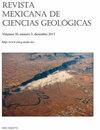A new species of Sigmodontinae (Rodentia) from the late Hemphillian of central Mexico, and comments on the possible radiation of this group
IF 0.5
4区 地球科学
Q4 GEOSCIENCES, MULTIDISCIPLINARY
Revista Mexicana De Ciencias Geologicas
Pub Date : 2019-11-30
DOI:10.22201/cgeo.20072902e.2019.3.1162
引用次数: 1
Abstract
The Sigmodontinae subfamily represents one of the most diverse groups of mammals in the world; this rodent group evolved in the open and arid ecosystems of the Miocene of North America and was the most successful legion of mammals in the Great American Biotic Interchange. Part of its diversification occurred in the Mexican Pliocene, in the Hemphillian-Blancan boundary, where Prosigmodon and Sigmodon species are very common. Recent molecular phylogenetic systematics research proposes that Sigmodon is related to South American sigmodontines, while studies of classical morphometry in isolated molar teeth consider Prosigmodon as a junior synonymy of Sigmodon, which modifies the biogeographic and chronostratigraphic interpretations of this group in America. In this paper, we describe a new species of Prosigmodon from the late Hemphillian (~4.89 Ma) of central Mexico based on jaws, maxillary and complete isolated teeth. This is the most complete and austral record of the genus in North America. This species was compared with North American species of the Sigmodontinae and Neotominae subfamilies and we defined it as a new Prosigmodon species characterized by having a consistently present minute mesoloph in M1 and M2, in addition, there is an isolated metaconid from the protoconid in the m1 of young individuals. We performed a phylogenetic model using osteodental morphological characters focused on understanding the relationship between Prosigmodon (four species) and Sigmodon (eight species), also we included Baiomys (two species), Neotoma (two species), Peromyscus (two species), and Reithrodontomys (two species). Our results indicate that Prosigmodon is a monophyletic group if Sigmodon minor is included within the genus and P. chihuahuensis is excluded. The Mexican Prosigmodon species have more apomorphic characters with respect to S. minor and P. holocuspis. The species of Prosigmodon and Sigmodon are not closely related. The Sigmodon species are more closely related to the Neotoma species than to the species of Baiomys, Prosigmodon, Reithrodontomys and Peromyscus. Based on the topology of our cladogram and the stratigraphic ranges of the species of Sigmodontinae and Neotominae, we discuss that Baiomys, Prosigmodon, Reithrodontomys and Peromyscus probably diversified in the early Hemphillian (late Miocene), while Sigmodon and Neotoma did so during the late Pliocene.墨西哥中部亨菲利亚晚期斑齿兽科(啮齿目)一新种,并对该群可能辐射的评述
Sigmodontinae亚科代表了世界上最多样化的哺乳动物群体之一;这种啮齿动物是在北美中新世开放和干旱的生态系统中进化而来的,是美洲生物大交换中最成功的哺乳动物群体。它的部分多样化发生在墨西哥上新世,在Hemphillian-Blancan边界,在那里Prosigmodon和Sigmodon物种非常普遍。最近的分子系统发育系统学研究认为,Sigmodon与南美的sigmodontiines有亲缘关系,而对分离臼齿的经典形态测量学研究认为,Prosigmodon是Sigmodon的低级同系物,这改变了该类群在美洲的生物地理和年代地层学解释。本文描述了来自墨西哥中部Hemphillian (~4.89 Ma)晚期的Prosigmodon一新种,基于颌、上颌和完整的分离牙齿。这是北美最完整和最南方的属记录。将该物种与北美的Sigmodontinae和Neotominae亚科的物种进行比较,我们将其定义为一个新的Prosigmodon物种,其特征是在M1和M2中具有一致的微小中孔,此外,在年轻个体的M1中有一个从原孔体分离出来的元孔体。我们利用骨齿动物形态学特征建立了系统发育模型,重点了解了4种Prosigmodon和8种Sigmodon之间的关系,并纳入了2种Baiomys、2种Neotoma、2种Peromyscus和2种Reithrodontomys。结果表明,如果将小Sigmodon包括在属内,不包括P. chihuahuensis,则Prosigmodon为单系类群。墨西哥原形齿种相对于S. minor和P. holocuspis具有更多的异形特征。Prosigmodon和Sigmodon的物种关系并不密切。与Baiomys、Prosigmodon、Reithrodontomys和Peromyscus相比,Sigmodon种与Neotoma种的亲缘关系更近。根据我们的枝状图拓扑结构和Sigmodontinae和Neotominae的物种分布范围,我们认为Baiomys、Prosigmodon、Reithrodontomys和Peromyscus可能在Hemphillian早期(晚中新世)发生了分化,而Sigmodon和Neotoma在上新世晚期发生了分化。
本文章由计算机程序翻译,如有差异,请以英文原文为准。
求助全文
约1分钟内获得全文
求助全文
来源期刊

Revista Mexicana De Ciencias Geologicas
地学-地球科学综合
CiteScore
1.00
自引率
12.50%
发文量
0
审稿时长
6-12 weeks
期刊介绍:
Revista Mexicana de Ciencias Geológicas (RMCG) publishes original research papers on geological processes of broad interest, and particularly those dealing with regions of Latin America. The RMCG also publishes review papers on topics of current interest, and on the geology and tectonics of geological provinces of Latin America. Besides, it offers the opportunity for host editors to publish special thematic issues.
 求助内容:
求助内容: 应助结果提醒方式:
应助结果提醒方式:


